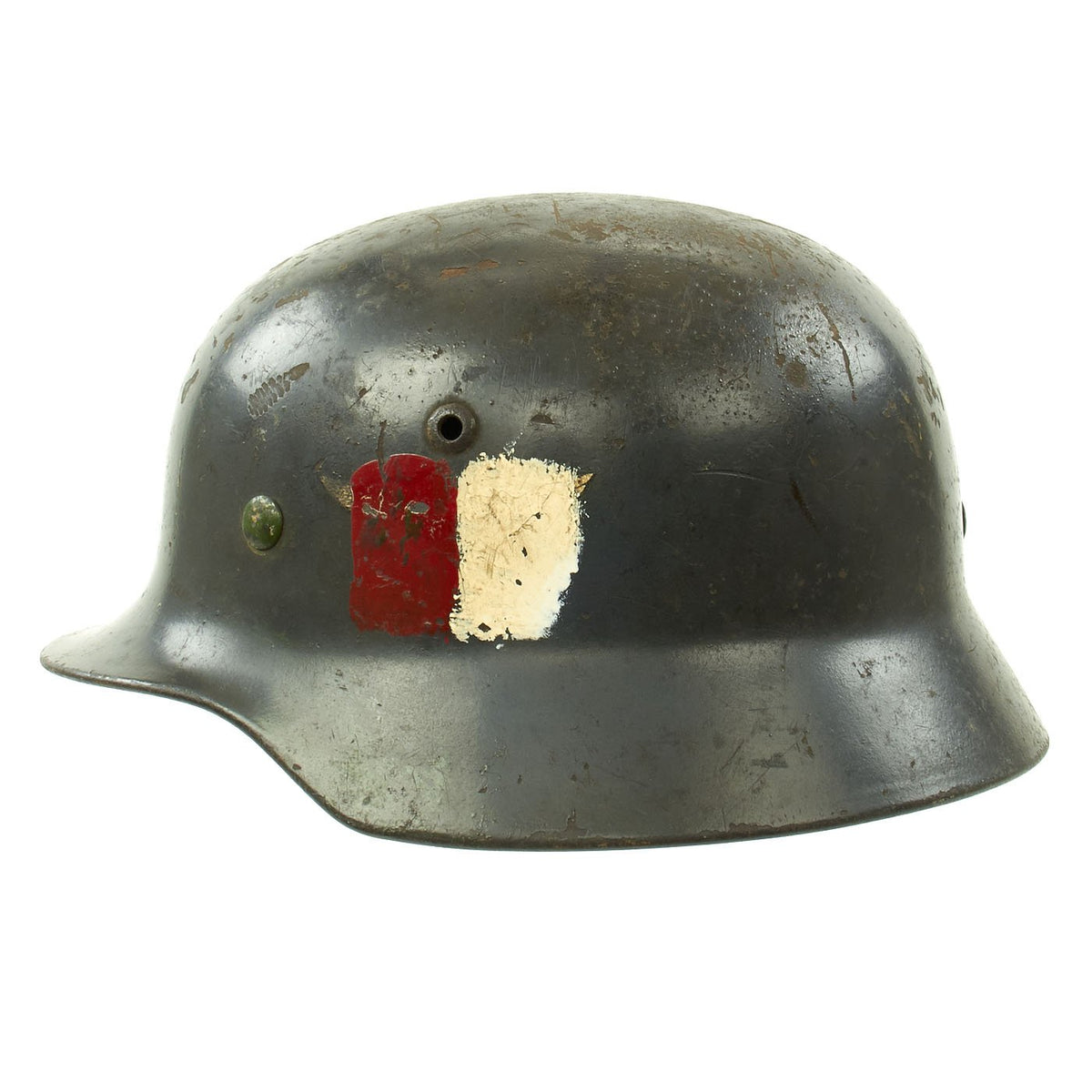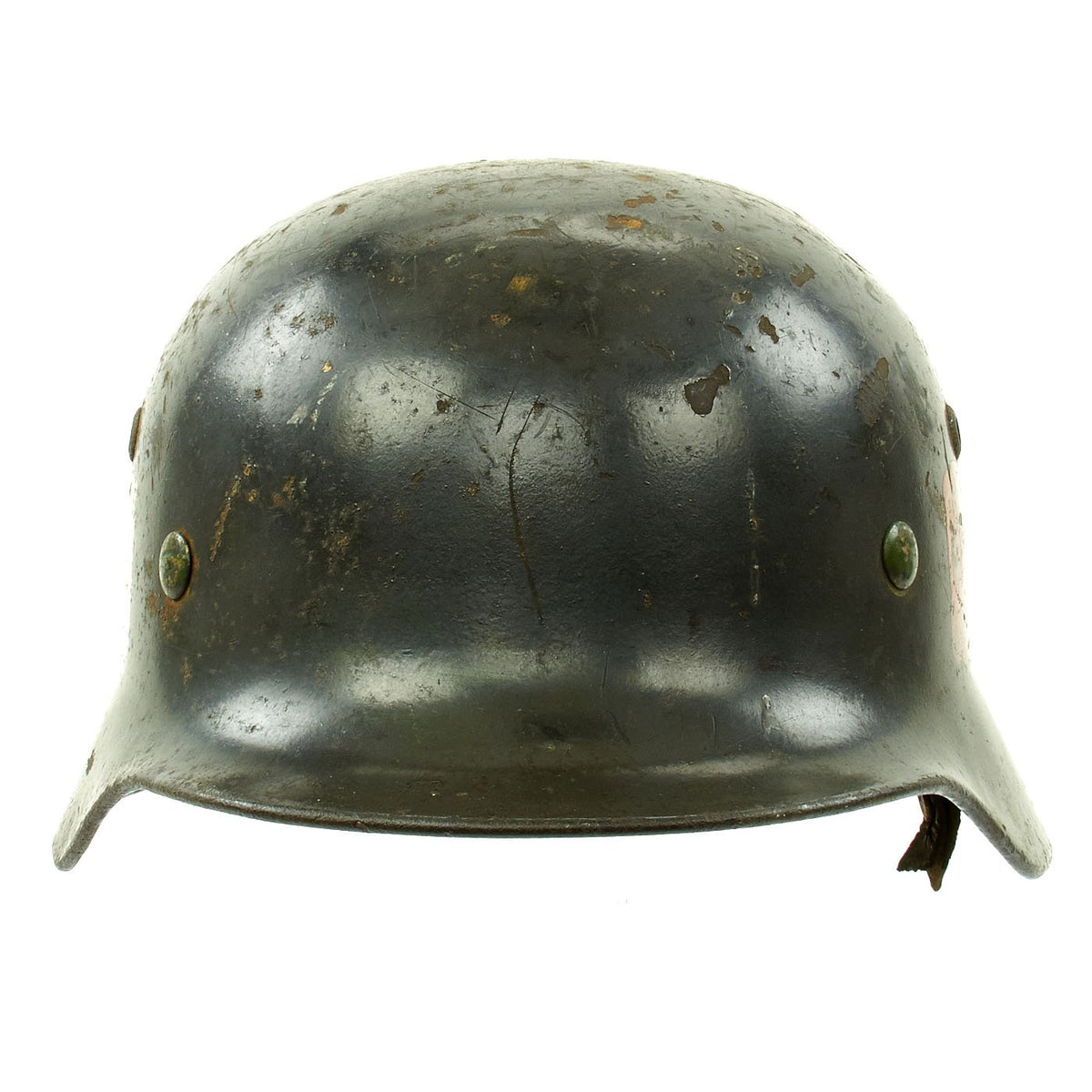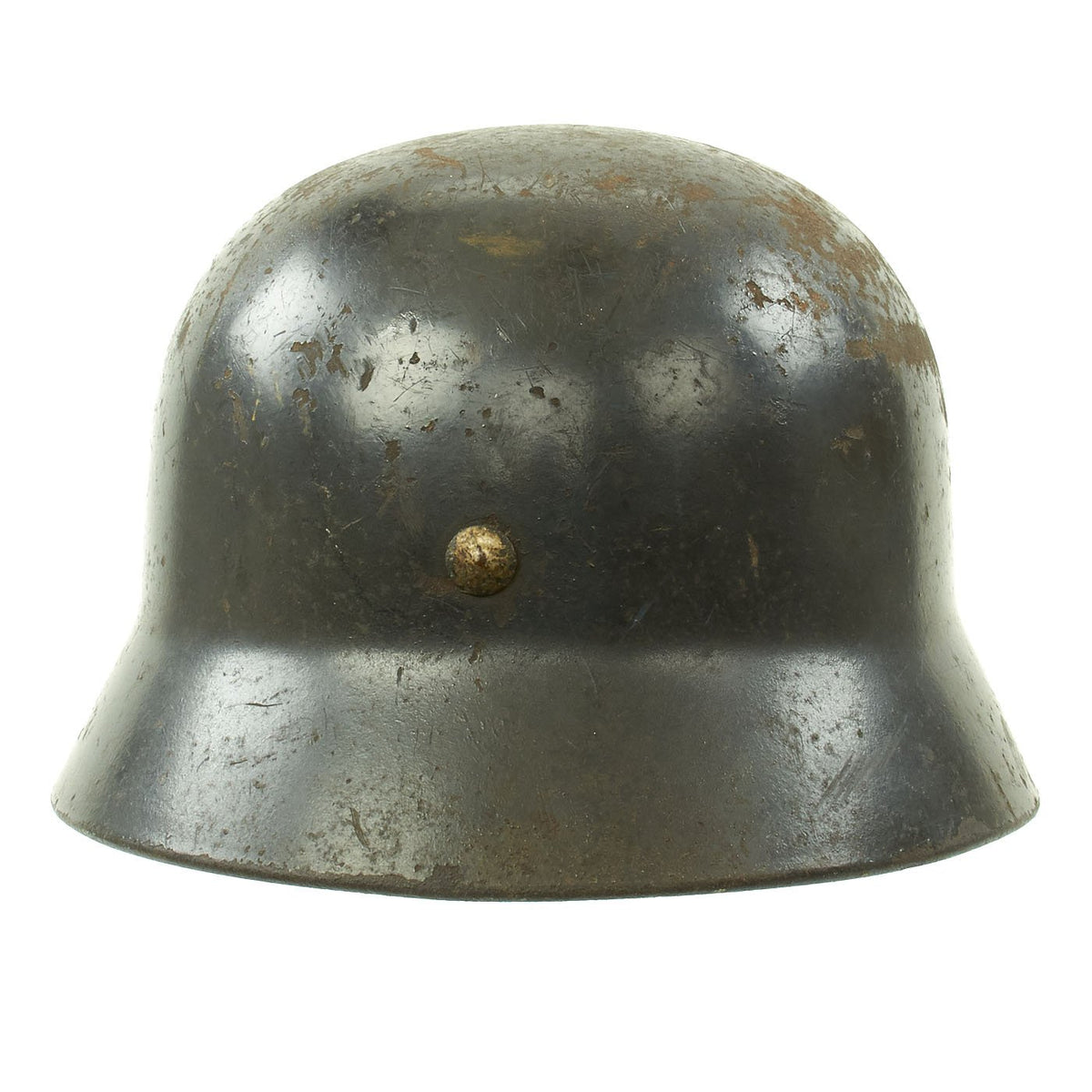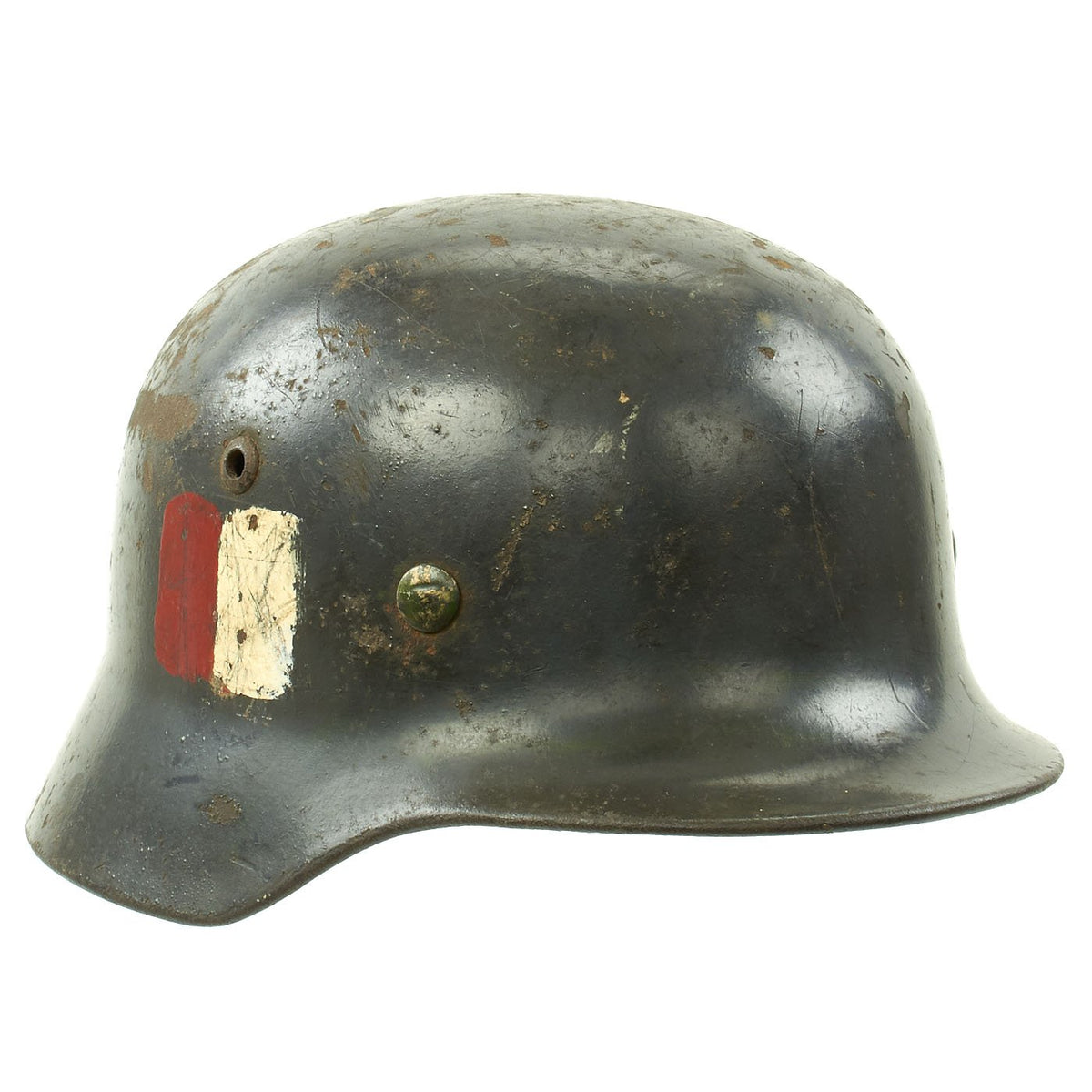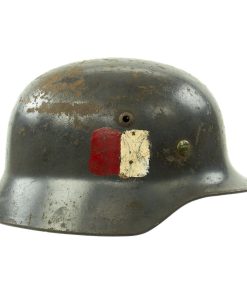Original German WWII M35 Single Decal Luftwaffe Helmet used by Czechoslovakian Resistance – Q64 Original Items
$ 995,00 $ 248,75
Original Item: Only One Available. The German occupation of Czechoslovakia (1938–1945) began with the German annexation of Sudetenland in 1938, continued with the March 1939 invasion of the Czech lands and creation of the Protectorate of Bohemia and Moravia, and by the end of 1944 extended to all parts of the former Czechoslovakia. During this time, the government in exile supported various resistance groups. Eventually by 1944 these coalesced into organized partisan military units.
What we have here is a very nice all original example early war Model 1935 German WWII helmet with a single Luftwaffe Eagle decal, which was captured and then used by the Czechoslovakian resistance. This stamped sheet steel construction helmet retains about 60% of the original Luftwaffe Blue-Gray paint, with some denting and paint chipping. It still has the original Luftwaffe Eagle decal, but it the helmet has had both the left and right sides painted with the Red and White resistance insignia. As these were German issue helmets, it was vitally important for the resistance to be able to quickly differentiate their forces. The wing tips of the eagle can still be seen on either side of the paint, and some traces can be seen through the paint as well.
The reverse, interior, neck guard apron is serial number stamped 1075 and the interior, left side, apron has the stamped manufacturer’s code and size, Q64 indicating that it was manufactured by Quist in the German city of Esslingen. Size 64 is a nice medium size that can accommodate liners from 56cm to 57cm or US 7 to 7 1/8. Size 64 shells are harder to find and are therefore more valuable to a collector.
All three original liner retaining pins are intact and have some of the original paint on the top. The interior of the helmet still has an original good M31 leather liner with all eight fingers, though the securing string is missing. The leather is quite soft, with a bit of tearing around the rim, with a medium brown color indicating light use. The outer side of the correct early war aluminum liner band over the left ear is marked 64 n.A / 56, indicating that this is a size 56 liner for a size 64 shell. The other side has the manufacturer and date in a circle:
D. R. P.
SCHUBERTH – WERK
K.-G.
1937
BRAUNSCHWEIG
The helmet chin strap is missing, except for a 1 inch long fragment attached to one of the square aluminum loops.
Overall a very interesting German WWII M35 helmet, which was captured and used by the Czechoslovakian resistance! Sure to appreciate in value over the years!
The first “modern” steel helmets were introduced by the French army in early 1915 and were shortly followed by the British army later that year. With plans on the drawing board, experimental helmets in the field, (“Gaede” helmet), and some captured French and British helmets the German army began tests for their own steel helmet at the Kummersdorf Proving Grounds in November, and in the field in December 1915. An acceptable pattern was developed and approved and production began at Eisen-und Hüttenwerke, AG Thale/Harz, (Iron and Foundry Works), in the spring of 1916.
These first modern M16 helmets evolved into the M18 helmets by the end of WWI. The M16 and M18 helmets remained in usage through-out the Weimar Reichswehr, (National Defence Force, Circa 1919-1933), era and on into the early years of the Third Reich until the development of the smaller, lighter M35 style helmet in June 1935.
In 1934 tests began on an improved Stahlhelm, whose design was a development of World War I models. The Eisenhüttenwerke company of Thale carried out prototype design and testing, with Dr. Friedrich Schwerd once again taking a hand.
The new helmet was pressed from sheets of molybdenum steel in several stages. The size of the flared visor and skirt was reduced, and the large projecting lugs for the obsolete armor shield were eliminated. The ventilator holes were retained, but were set in smaller hollow rivets mounted to the helmet’s shell. The edges of the shell were rolled over, creating a smooth edge along the helmet. Finally, a completely new leather suspension, or liner, was incorporated that greatly improved the helmet’s safety, adjustability, and comfort for each wearer. These improvements made the new M1935 helmet lighter, more compact, and more comfortable to wear than the previous designs.
The Army’s Supreme Command officially accepted the new helmet on June 25, 1935 and it was intended to replace all other helmets in service.
The M1935 design was slightly modified in 1940 to simplify its construction, the manufacturing process now incorporating more automated stamping methods. The principal change was to stamp the ventilator hole mounts directly onto the shell, rather than utilizing separate fittings. In other respects, the M1940 helmet was identical to the M1935. The Germans still referred to the M1940 as the M1935, while the M1940 designation were given by collectors.
Fast Shipping with Professional Packaging
Thanks to our longstanding association with UPS FedEx DHL, and other major international carriers, we are able to provide a range of shipping options. Our warehouse staff is expertly trained and will wrap your products according to our exact and precise specifications. Prior to shipping, your goods will be thoroughly examined and securely secured. We ship to thousands clients each day across multiple countries. This shows how we're dedicated to be the largest retailer on the internet. Warehouses and distribution centres can be located throughout Europe as well as the USA.
Note: Orders with more than one item will be assigned a processing date depending on the item.
Before shipping before shipping, we'll conduct a thorough inspection of the items you have ordered. Today, the majority of orders will be delivered within 48 hours. The delivery time will be between 3-7 days.
Returns
The stock is dynamic and we cannot completely manage it because multiple stakeholders are involved, including our factory and warehouse. So the actual stock may alter at any time. It's possible that you may not receive your order once the order has been made.
Our policy is valid for a period of 30 days. If you don't receive the product within 30 days, we are not able to issue a refund or an exchange.
You can only return an item if it is unused and in the same state as the day you received it. You must have the item in its original packaging.
Related products
Uncategorized
Uncategorized
Uncategorized
Uncategorized
Uncategorized
Band of Brothers ORIGINAL GERMAN WWII Le. F.H. 18 10.5cm ARTILLERY PIECE Original Items
Uncategorized
Uncategorized
Uncategorized
Uncategorized
Angolan Rebel 1970s era 60mm Inert Display Mortar from Angolan Civil War Original Items
Uncategorized
Armoured Fighting Vehicles of the World: AFVs of World War One (Hardcover Book) New Made Items
Uncategorized
Uncategorized
Uncategorized
Armored Burgonet Helmet & Polearm from Scottish Castle Leith Hall Circa 1700 Original Items
Uncategorized
Uncategorized
Uncategorized
Uncategorized
Uncategorized
Australian WWII Owen MK1 Machine Carbine SMG Custom Fabricated Replica with Sling Original Items

